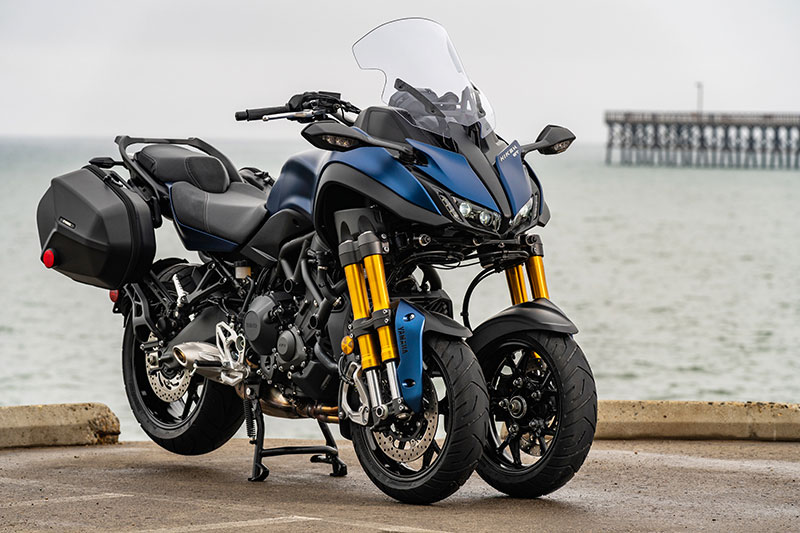2019 Yamaha Niken GT

First Ride Review
Following our first ride on the 2019 Niken at the press introduction in Europe, Yamaha pre-sold every one of the relatively few examples it brought to the States, and test units of the world’s first production Leaning Multi-Wheeled motorcycle were tough to come by. Although I was able to write a fairly comprehensive review of the two-front-wheeled bike based on the 140-mile intro ride, questions still remained. Namely, how does the Niken work on the wet, dirty, snotty, bumpy roads it was designed to tame, rather than just licked-clean, dry and perfectly surfaced twisties in the Austrian alpine sunshine? Fortunately we were able to get back on the LMW’s saddle recently at the launch of the 2019 Niken GT on some wonderfully varied roads in Central California. And not only did it rain all freakin’ day, I was able to abscond with a test bike to put on our scale and into the curious hands of the entire Rider staff.
My riding impressions, the tech details and features of the Niken in my First Ride Review still hold true, but know this: Regardless of your feelings about its angry-robot looks, the 580-600-pound wet weight (depending on model) of the 3-cylinder, 847cc bike or insecurities about being seen on such a weird and groundbreaking motorcycle, I have never ridden faster around a corner in the rain on a machine that leans in my entire life. In the pouring rain on the tightest, slickest, bumpiest part of snaky Tepusquet Canyon Road, I repeatedly tried to break the Niken GT’s front end loose, and failed. There is so much grip front and rear that–while it takes some time to put your trust in the disconnected feeling common to alternative front ends–once you do the Niken will simply keep leaning farther and farther without a hint of looseness or instability, right up to the 43 degrees of lean when its footpeg feelers touch tarmac. With two tires up front, should one tire slip in some dirt or leaves the other takes over, during braking as well as cornering, and road irregularities like tar snakes and rain grooves simply disappear. The sense of effortless stability from the steering and suspension is unequaled by any normal motorcycle as well.
Sure, a good sportbike can exceed 43 degrees of lean without trying hard, even the 45 degrees of which the Niken is capable before its parallel quadrilateral support arms bottom out. The Niken and Niken GT aren’t intended to push cornering extremes, but to add a level of confidence to everyday riding and safety to riding in poor road conditions. Since it’s a full-size motorcycle, not a scooter, doesn’t have a tilt lock and must be held up at stops and parked on its sidestand (or GT’s centerstand), the Nikens are intended for experienced riders, perhaps those looking for a little less worry or stress when riding in the rain or at a brisk pace. Most of all they’re a lot of fun to ride thanks to that riding-on-rails stability combined with sportbike-like agility–every time I ride one I’m reminded of the Speeder bikes in “Star Wars” zipping through the trees in the Endor forest. And yes, you can easily share or split lanes–the handlebar is the widest part of the bike, and it’s no wider than a typical adventure bike bar. I’d still like more bite from the front brakes–although there’s an opposed 4-piston caliper on each wheel, the discs are smallish at 266mm–and while the heated grips worked well on the low and medium settings, on our test bike they didn’t heat evenly on high.
The Niken is part of Yamaha’s sport-touring lineup, and well it should be, given its relaxed upright seating. Unlike the Tracer 900 it’s based upon, footpegs are underneath the rider rather than behind, and are low enough to allow plenty of legroom. There’s a natural reach to the high, wide handlebar, which doesn’t put any weight on your wrists, and comfortable weight distribution between your butt and feet. The Niken GT takes the touring equation several steps further by adding a wider, taller windscreen, heated grips, comfort rider and passenger seats, a passenger grab rail that is top-case ready, an additional 12-watt power outlet, a pair of quick-release 25-liter saddlebags and a centerstand. Although not quite big enough to hold a full-face helmet, the semi-soft, zippered clamshell saddlebags have a slick, lightweight design to help keep the GT’s load capacity above 400 pounds. Separate waterproof liners and small combination locks for the zippers keep you gear dry and secure, and both the bags and mounting racks lock to the bike but release easily so you can take just the bags with you or remove the entire setup, leaving just a small mounting stub on either side.
All told the GT package only adds 20 pounds, and all of its components work exceptionally well. The comfort seats are plush and cozy for long rides (though they do raise the rider’s seat height about an inch, which puts me on my tiptoes at stops), the windscreen provides good upper body coverage and the centerstand eases final drive-chain service (and lets you lift the front to show off the movement of the parallel fork support arms). For more wind protection a 2.4-inch-taller windscreen is available for the Niken GT, and Yamaha offers heated comfort seats as well.
As Yamaha’s and the world’s first production LMW motorcycle, given the small number of Nikens and Niken GTs the company is offering globally (and their premium pricing), I have to believe that it’s testing the waters in the real world not just to see how well its known performance parameters are accepted, but also its unknown ones–what sort of effect might the Niken have on a rider’s attitude about going back to a regular bike with “just” one wheel in front, for example? Given its testing of more extreme LMW variations and even self-balancing autonomous motorcycles, you have to believe that the Niken is just the first salvo in a separate line of LMWs if it shows promise. Imagine its front end on an FJR1300, for example, with tilt lock as an option. Sport touring would never be the same.
